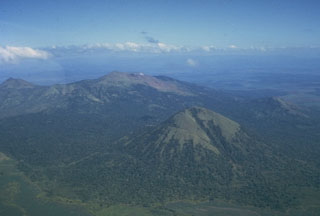Report on Las Pilas-El Hoyo Complex (Nicaragua) — March 1994
Bulletin of the Global Volcanism Network, vol. 19, no. 3 (March 1994)
Managing Editor: Richard Wunderman.
Las Pilas-El Hoyo Complex (Nicaragua) Dense white plumes issue from a 10-m-diameter pit crater
Please cite this report as:
Global Volcanism Program, 1994. Report on Las Pilas-El Hoyo Complex (Nicaragua) (Wunderman, R., ed.). Bulletin of the Global Volcanism Network, 19:3. Smithsonian Institution. https://doi.org/10.5479/si.GVP.BGVN199403-344080
Las Pilas-El Hoyo Complex
Nicaragua
12.4922°N, 86.6786°W; summit elev. 1088 m
All times are local (unless otherwise noted)
On 6 March 1994, we visited Las Pilas to determine the source and nature of a dense white plume, visible for at least 10 km to the S, that rose from the upper S slope of the volcano. The plume, which smelled strongly of sulfur, emerged from the bottom of a small phreatic (?) pit crater. The crater measured roughly 10 m in diameter and 5-10 m deep. The pit walls were vertical, and the pit opening was mantled by a thin coating of native sulfur. Extensive mixing with atmospheric gases occurred before the plume rose from the pit. Immediately downslope from the crater there appeared to be bedded volcanic deposits. Their presence suggests that the pit crater was the source of numerous phreatic-phreatomagmatic explosions.
We briefly examined a large, circular phreatic pit crater 50-75 m W of the small phreatic pit. This larger crater was about 30-40 m in diameter, and roughly 30 m deep. The phreatic explosion that produced the crater must have been unusually powerful, because it disrupted several (5-7 m thick) basaltic lava flows. No fumarolic activity was observed at this crater, and we saw no evidence of surge deposits in its vicinity. A Hewlett Packard chromatograph of in-situ soils at Las Pilas yielded 0.19 and 0.21 vol. % CO2, values probably within the range of background in local volcanic soils (0.04-0.1 vol.%).
CO2 in soils at volcanic areas varies considerably, and includes some relatively high values. A preliminary survey of the literature suggests soil gas CO2 in volcanic areas ranges from ten to several-hundred times the background found in many non-volcanic areas.
Geological Summary. Las Pilas-El Hoyo volcanic complex, overlooking Cerro Negro volcano to the NW, includes a diverse cluster of cones within about a 3-km-diameter area. A N-S-trending fracture system cutting across the edifice is marked by numerous flank vents, including maars, that are part of a 30-km-long volcanic massif. The Cerro Negro chain of cinder cones is listed separately in this compilation because of its extensive historical eruptions and possible distinct magmatic system. The lake-filled Asososca maar is located adjacent to the Cerro Asososca cone on the southern side of the fissure system, south of the axis of the Marrabios Range. Two small maars west of Lake Managua are located at the southern end of the fissure. Aside from a possible eruption in the 16th century, eruptions of Las Pilas took place in the 1950s from a fissure that cuts the eastern side of the 700-m-wide crater and extends down the N flank.
Information Contacts: Cristian Lugo, Instituto Nicaraguense de Estudios Territoriales (INETER), Apartado 17610-2110, Managua, Nicaragua; Michael Conway, Andrew Macfarlane, and Peter LaFemina, Florida International Univ (FIU), Miami, FL 33199 USA; John B. Murray, Ben van Wyk de Vries, and Adam Maciejewski, Open Univ, Milton Keynes, MK7 6AA, U.K..

